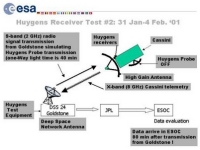Huygens relay link mystery fully unravelled
2 February 2001
A special calibration test is being conducted with the Huygens receivers on board Cassini. This test is the first key milestone of the work performed by the Huygens Recovery Task Force which has been jointly set up by ESA's Science Director and NASA's Science Associate Administrator. The test results will provide a solid engineering basis for the design of new mission scenarios which can recover the Huygens relay link performance.The main purpose of the test is to acquire a complete data set that will allow to fully characterize the performances of the flight radio receivers. These data will be used to correlate their performances with those that were measured on the Engineering Model at ESOC and to verify and calibrate a detailed analytical receiver model.
In the past few months, significant progress has been made in understanding the performances of the Huygens radio receivers. A detailed analytical model of its bandwidth has been worked by ESA experts. This model has already been calibrated with the Engineering Model test results. The purpose of the in-flight test is to adjust the parameters in the model to make it match the performance of the flight receivers.
 |
|
Figure 1: Receiver test set-up |
The test started on 31 January and will last 5 days. It uses NASA's Deep Space Antenna in Goldstone to transmit to and receive data from Huygens via Cassini. Each test session lasts about 10 hours/day when the Goldstone antenna is in view of Cassini. Details about the test set-up are provided in Figure 1.
The test set-up is essentially the same as the one that was used during the first test performed in February 2000. ESA's teams in Darmstadt and in Goldstone are working round the clock to obtain as much information as possible during the five days allocated to perform the test.
 |
 |
|
Figure 2: Channel A preliminary results |
Figure 3: Channel B preliminary results |
Preliminary results obtained during the past two days are encouraging. They provide a detailed characterization of the receiver and confirm the validity of the analytical model, as shown in Figure 2 (for channel A) and Figure 3 (for channel B). These results are preliminary and further adjustment of the data will be obtained after a detailed processing of the vast amount of data (1 gigabit per day) that is being returned. These maps are now used to isolate regions where more detailed investigation should be conducted over the remaining part of the test campaign.

